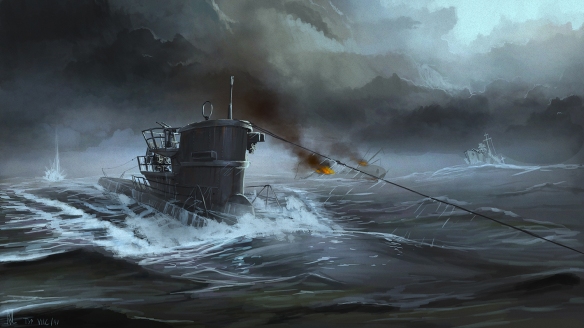When the Germans learnt of the transfer they determined to sink ARKHANGELSK in the same way that Prien in U-47 had sunk ARKHANGELSK’s sister ship ROYAL OAK. This would make a great propaganda coup and lift the spirits of the German public and military who at this point in the war could see that the end was getting closer for Germany. The U-315 was ordered to penetrate Kola Inlet and torpedo the ARKHANGELSK.
On the dark night of 19th September 1944, Herbert Zoller took his Schnorchel fitted U-315 towards the entrance to Kola Inlet and learned to his horror, that the Soviets had strung an anti-submarine net across the entrance to the Inlet , in which U-315 became firmly entangled. They tried again and again, all through the night, but to no avail, the submarine would not budge; she was trapped.
The clock was ticking and soon the morning sun would reveal to the Soviets that they had snagged a U-Boat in their net and the end would come quickly for the men aboard U-315. A further try to break free was made and the submarine finally broke free. Zoller decided that it was impossible to penetrate the defences of the Inlet and he returned to base.
Battleship Royal Sovereign after handed over to the Soviet navy as Arkhangelsk.
The Arctic shared the distinction of being an active theatre of naval operations. In these cold northern waters the Western Allies and the Soviet Union were engaged against the Germans in a remorseless struggle for supremacy around the Polar coast and the Barents Sea. Apart from the Loch Ewe–Murmansk convoys which had now become a continuing source of frustration for the Germans, where once they had afforded rich promise, the Soviets were themselves confronted by the difficulty of laying waste the strongly defended German shipping convoys operating out of the naval base of Kirkenes. Despite possessing the advantages of aerial reconnaissance and having active support from units of fighter and torpedo bombers, as well as submarines and fast torpedo cutters, these combined arms operations rarely came close to inflicting real harm, let alone major destruction, on this enemy shipping until the Germans finally decided to pull back their troops from the Murmansk front in October 1944. Only then as the XIX Mountain Corps was withdrawn and the Soviet 14th Army, ably assisted by the Northern Fleet under Admiral Arseni Golovko, launched their offensive into the region the Germans had left behind was there any real change in the situation. By the time the 131st Rifle Corps entered the port of Kirkenes on 26 October, the Germans had already left. Although great efforts were made by the Soviet military to attack as many of the evacuation convoys as possible, the sweeping claims about the degree of destruction inflicted upon this shipping made by the submariners and those on the Soviet torpedo cutters and MTBs assigned to the task could not be sustained. Of the twenty assorted vessels that were sunk, twelve succumbed to the waves of air attacks that broke over them. Despite this unwanted attention from enemy forces, the vast majority of the German shipping got away from the Polar coast unscathed taking with them over 40,000 tons of supplies. Once again the Germans had pulled off a successful evacuation under trying conditions. They were learning fast and becoming masters of the art, a distinction undoubtedly helped by the fact that they were getting the most practice at staging this sort of retreat. Before they finally withdrew or were pushed from Russian territory, the Germans had tried to take the fight to the Soviets elsewhere on the Northern Front, but these adventures had enjoyed only mixed success. Their U-boat operations against Soviet mercantile traffic along the Siberian sea route were very much hit-and-miss affairs with greater accent on the latter than the former. Theirs was a lonely and unglamorous quest – but even the potentially more eye-catching spectacles, such as the repeated attempts in September and October by the schnorchel U-boats U-315 and U-313 to penetrate the Kola Inlet in order to attack the old battleship Arkhangelsk, didn’t succeed either.
